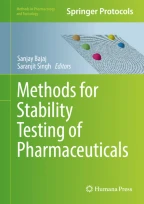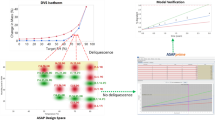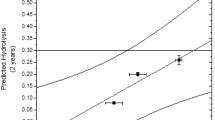Predictive Stability Testing Utilizing Accelerated Stability Assessment Program (ASAP) Studies

Predictive stability studies allow the long-term stability characteristics of a drug substance or drug product to be characterized from extrapolation of results from a short-term stressed stability study. These studies are typically one month in duration and focus on chemical degradation. This chapter focuses on accelerated stability assessment program (ASAP) studies as one method of predicting stability. The main phases of performing an ASAP study are described including designing the protocol, setting down the studies, storing and analyzing the samples followed by reviewing and modeling the data and performing predictions. The applications of predictive stability studies are also discussed including in regulatory submissions.
This is a preview of subscription content, log in via an institution to check access.
Subscribe and save
Springer+ Basic
€32.70 /Month
- Get 10 units per month
- Download Article/Chapter or eBook
- 1 Unit = 1 Article or 1 Chapter
- Cancel anytime
Buy Now
Price includes VAT (France)
eBook EUR 71.68 Price includes VAT (France)
Softcover Book EUR 89.66 Price includes VAT (France)
Hardcover Book EUR 126.59 Price includes VAT (France)
Tax calculation will be finalised at checkout
Purchases are for personal use only
Similar content being viewed by others

Considerations for Updates to ICH Q1 and Q5C Stability Guidelines: Embracing Current Technology and Risk Assessment Strategies
Article 16 September 2021

Accelerated Predictive Stability Study of a Pediatric Drug Product for a Supplemental New Drug Application
Article 06 June 2024

Utilization of risk-based predictive stability within regulatory submissions; industry’s experience
Article Open access 11 May 2020
References
- Waterman K, Adami R (2005) Accelerated aging: prediction of chemical stability of pharmaceuticals. Int J Pharm 293:101–125 ArticleCASPubMedGoogle Scholar
- Waterman K, Carella A, Gumkowski M et al (2007) Improved protocol and data analysis for accelerated shelf-life estimation of solid dosage forms. Pharm Res 24(4):780–790 ArticleCASPubMedGoogle Scholar
- Waterman K, Colgan S (2008) A science-based approach to setting expiry dating for solid drug products. Regulatory Rapporteur 5(7):9–14 Google Scholar
- Waterman K (2011) The application of Accelerated Stability Assessment Program (ASAP) to Quality by Design (QbD) for drug product stability. AAPS PharmSciTech 12(3):932–937 ArticleCASPubMedPubMed CentralGoogle Scholar
- Waterman K, Swanson J, Lippold B (2014) A scientific and statistical analysis of accelerated aging for pharmaceuticals. Part 1: accuracy of fitting methods. J Pharm Sci:1–7. https://doi.org/10.1002/jps.24075
- Waterman K, Macdonald B (2010) Package selection for moisture protection for solid oral drug products. J Pharm Sci 99(11):4437–4452 ArticleCASPubMedGoogle Scholar
- Williams H, Stephens D, McMahon M et al (2017) Risk-based predictive stability—an industry perspective. Pharm Tech 41(3):52–57 Google Scholar
- Colgan S, Watson T, Whipple R et al (2012) The application of science- and risk-based concepts to drug substance stability strategies. J Pharm Innov 7:205–213 ArticleGoogle Scholar
- Kougoulos E, Smales I, Verrier H (2011) Towards integrated drug substance and drug product design for an active pharmaceutical ingredient using particle engineering. AAPS PharmSciTech 12(1):287–294 ArticleCASPubMedPubMed CentralGoogle Scholar
- Oliva A, Fariña J, Llabrés M (2012) An improved methodology for data analysis in accelerated stability studies of peptide drugs: practical considerations. Talanta 94:158–166 ArticleCASPubMedGoogle Scholar
- Clancy D, Hodnett N, Orr R et al (2016) Kinetic model development for accelerated stability studies. AAPS PharmSciTech online. https://doi.org/10.1208/s12249-016-0565-4
- Kleinman M, Baertschi S, Alsante K (2014) In silico prediction of pharmaceutical degradation pathways: a benchmarking study. Mol Pharm 11:4179–4188 ArticleCASPubMedGoogle Scholar
- Andersson T, Broo A, Evertsson E (2014) Prediction of drug candidates’ sensitivity toward autoxidation: computation estimation of C-H dissociation energies of carbon-centered radicals. J Pharm Sci 103(1):1949–1955 ArticleCASPubMedGoogle Scholar
- Remmelgas J, Simonutti A-L, Ronkvist Å (2013) A mechanistic model for the prediction of in-use moisture uptake by packaged dosage forms. Int J Pharm 441:316–322 ArticleCASPubMedGoogle Scholar
- Waterman K, Chen L, Waterman P et al (2016) Modeling of in-use stability for tablets and powder in bottles. Drug Dev Ind Pharm 42:1571–1578. https://doi.org/10.3109/03639045.2016.1153648ArticlePubMedCASGoogle Scholar
- Li H, Nadig D, Kuzmission A et al (2016) Predictions of the changes in drug dissolution from an immediate-release tablet containing two active pharmaceutical ingredients using an accelerated stability assessment program. AAPS Open 2:7. https://doi.org/10.1186/s41120-016-0010-5ArticleGoogle Scholar
- International Consortium for Innovation and Quality in Pharmaceutical Development. http://iqconsortium.org
- Freed A, Clement E, Timpano R (2014) Regulatory responses to the use of various lean stability strategies in early drug development. Regulatory Rapporteur 11(7/8):5–8 Google Scholar
- Greenspan L (1977) Humidity fixed points of binary saturated aqueous solutions. J Res Natl Bur Stand A Phys Chem 81A(1):89–96 ArticleGoogle Scholar
- Fu M, Perlman M, Lu Q, Varga C (2015) Pharmaceutical solid-state kinetic stability investigation by using moisture-modified Arrhenius equation and JMP statistical software. J Pharm Biomed Anal 107:370–377 ArticleCASPubMedGoogle Scholar
- Waterman K, Gerst P, Macdonald B (2012) Relative humidity hysteresis in solid-state chemical reactivity: a pharmaceutical case study. J Pharm Sci 101(2):610–615 ArticleCASPubMedGoogle Scholar
Acknowledgements
The author would like to thank Faye Turner, Dr. Steve Cosgrove, Anna Powell, and Dr. Jonathan Bright from AstraZeneca for their contributions.
Author information
Authors and Affiliations
- AstraZeneca, Macclesfield, UK Helen Williams
- Helen Williams




